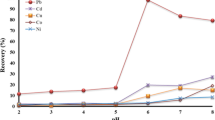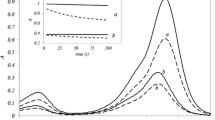Abstract
Phenanthraquinone monophenyl thiosemicarbazone (PPT), an excellent color-forming chelating agent, combines to Pb(II) to form a slightly soluble complex in aqueous solution. To determine this metal ion, a tedious and time-consuming separation technique, such as liquid–liquid extraction, has to be performed. However, the Pb(II)-PPT complex could be determined conveniently by ultraviolet-visible (UV-Vis) spectrophotometry at 520 nm in a Tween 80 micellar medium that has polyoxyethylene groups. After conditions, such as the pH, the concentration of PPT and the stability, were adjusted to their optimum values, the sensitivities of the Pb(II) ions in the Tween 80 micellar medium and in chloroform were compared. It was shown that the sensitivity of Pb(II) in the Tween 80 micellar medium was higher than in chloroform. The interference from different cations and anions was studied. Beer’s law was obeyed over a concentration range of 0–40 μg mL−1. The detection limit of Pb(II) was 0.036 μg mL−1. The recovery yields of the lead(II) in the synthetic mixtures and water samples ranged from 98 to 99.8%, and their relative standard deviations (RSD) were below 4%. The proposed method was successfully applied to the determination of lead in certified reference samples, biological samples and in environmental water samples.
Similar content being viewed by others
References
B. L. Carson, H. V. Ellis, and J. L. McCann, “Toxicology and Biological Monitoring of Metals in Humans”, 1987, Lewis, Michigan.
A. K. De, “Environmental Chemistry”, 3rd ed., 1996, New Age International (P) Limited, New Delhi, 263.
R. A. Goyer, in “Casarett and Doull’s Toxicology: The Basic Science of Poisons”, ed. C. D. Klaassen and M. O. Amdur, 3rd ed., 1986, J. Doull, MacMillan Publishing Company, New York, 598.
M. E. Khalifa and H. M. A. El-Nader, Rev. Chim., 1996, 47, 360.
M. A. Akl, Anal. Sci., 2001, 17, 561.
M. E. Khalifa, M. A. Akl, and S. E. Ghazy, Chem. Pharm. Bull., 2001, 49, 664.
M. A. Akl, M. E. Khalifa, S. E. Ghazy, and M. M. Hassanein, Anal. Sci., 2002, 18, 1235.
Chem. Eng. News, 1976, 54(6), 6.
Chem. Eng. News, 1976, 54(6), 7.
M. E. D. Garcia and A. S. Medel, Talanta, 1986, 33, 255.
G. B. Sandell, “Colorimetric Determination of Traces of Metals”, 3rd ed., 1965, Interscience, New York.
L. C. Willemsons, “International Lead Zinc Research Organization”, 1986, New York, 71.
M. N. Bale, D. P. Dave, and A. D. Sawant, Talanta, 1995, 42, 1291.
Y. Zhu, W. Jiang, G. Jing, and W. Liu, Indian J. Chem., 1996, 35, 1009.
M. Xiao, Lihua Jianyan Huaxue Fence, 1988, 24, 130.
S. L. C. Ferreira, M. G. M. Andrade, I. Lobo, and A. C. S. Costa, Anal. Lett., 1991, 24, 1675.
G. V. Ralkaiah and M. C. Eshwar, Indian J. Technol., 1985, 23, 157.
L. C. Willemsons, “International Lead Zinc Research Organization”, 1986, New York, 82.
J. Pan, Y. Chen, and H. Yan, Shanghai Science and Technology Press, 1981, Shanghai, 411.
J. Pan, Z. Li, and C. G. Hsu, Fenxi Shiyanshi, 1994, 13, 29.
G. Yong, D. Bingjun, L. Yongwen, C. Xijun, and M. Shuangming, Michrochim. Acta, 2004, 144, 257.
P. Becher, in “Surfactant Science Series”, ed. M. J. Schick, 1966, Vol. 1, Marcel Dekker, New York, 559.
P. Becher, in “Surfactant Science Series”, ed. M. J. Schick, 1966, Vol. 1, Marcel Dekker, New York, 481.
M. J. Rosen, “Surfactants and Interfacial Phenomena”, 1987, Wiley, New York.
M. Corti, C. Minera, and V. Degiorgia, J. Phys. Chem., 1984, 88, 309.
G. L. Long and J. D. Wineforder, Anal. Chem., 1980, 52, 2242.
M. C. Reddy, M. L. P. Reddy, T. R. Prasada, C. S. P. Iyer, and A. D. Damandara, Chem. Anal. [Warsaw], 1997, 42, 675.
E. A. Greenberg, S. L. Clesceri, and D. A. Eaton (ed.), “Standard Methods for the Examination of Water and Wastewater”, 18th ed., 1992, American Public Health Association, Washington, D. C., 3.
Author information
Authors and Affiliations
Corresponding author
Rights and permissions
About this article
Cite this article
Akl, M.A. An Improved Colorimetric Determination of Lead(II) in the Presence of Nonionic Surfactant. ANAL. SCI. 22, 1227–1231 (2006). https://doi.org/10.2116/analsci.22.1227
Received:
Accepted:
Published:
Issue Date:
DOI: https://doi.org/10.2116/analsci.22.1227




